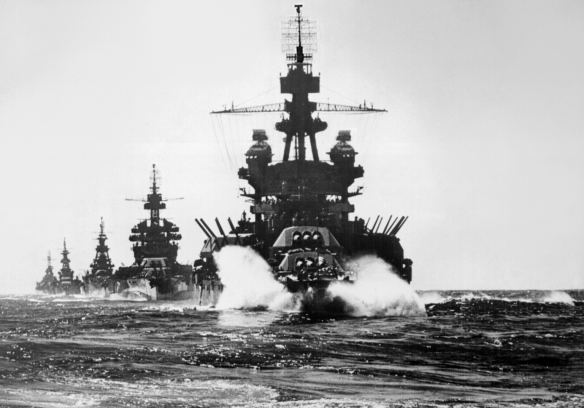Pennsylvania (1915) leading battleship Colorado (1921) and cruisers Louisville (1930), Portland (1932), and Columbia (1941) into Lingayen Gulf, Philippines 1944.
The Italian BB Littorio
When the self-propelled Whitehead torpedo—carried on small, fast torpedo boats—threatened the established order, naval hierarchies pursued ways to preserve the battleship’s preeminence. Naval architects modified battleship hulls to absorb torpedo hits. Naval tacticians countered the torpedo by expanding the defensive ring around battleships using torpedo boat destroyers. The same ideas of defense in depth, combined with technical improvements, governed later attempts to protect the battleship from submarines and aircraft.
After World War II, the navy created a technological hierarchy to protect the aircraft carrier just as it had with the battleship. Components of the aviation technological paradigm—even small ones like the ULQ-6 I encountered as a junior naval officer—contributed to preserving the new status quo and attempted to relegate counter weapons, and presumptive technological anomalies, to the periphery. As we begin a new century, there are strong indications that new presumptive anomalies threaten the aviation technological paradigm.
Despite its subsequent vilification by pundits, the battleship was not obsolete in December 1941. When the Japanese attacked Pearl Harbor—ignoring the fleet’s oil storage and repair facilities and missing the aircraft carriers (all were at sea)—they only managed to destroy older battleships already slated for replacement. The navy’s perceived future lay in the seventeen battleships on order and beginning to enter service, especially the six Iowas and five Montanas. Aviation-oriented historical assessments of the fast battleships minimize their relevance to the Pacific War and confuse their strategic mission with the obvious tactical use to which they were most often put: bolstering the antiaircraft defenses of joint battleship-aircraft carrier task forces.
During the Pacific War, the fast battleship and aircraft carrier became the exemplars of two, competing technological paradigms. The eventual ascendancy of carrier-based aviation was a near-run thing. Slightly earlier developments in sensor and gun technologies might have relegated aircraft to their 1924 status when towed aerial targets were being hit 75 percent of the time by ship-mounted guns during live-fire exercises. The earlier addition of radar-augmented defensive air patrols from fleet carriers would have blunted the effectiveness of attacking aircraft—in essence what happened by war’s end when search radars, radar-directed guns, and the proximity fuze combined to enhance fleet defense. Even so, the navy suffered tremendous losses at the hands of Japanese kamikazes—essentially antiship missiles—off Okinawa in 1945.
By war’s end, the U.S. Navy had fulfilled Secretary of the Navy James Forrestal’s wish and had become an air navy. The aircraft carrier had proven its ability to dominate Admiral Fullam’s “three-plane” war at sea. Naval aviation could concentrate incredible destructive power against sea and shore targets at ranges over 200 miles. After Japan’s surrender, no enemy battleships existed to challenge American carriers at night or during bad weather, and the battleship became difficult to justify both inside and outside the navy. The battleship soon became irrelevant in a navy desperately struggling to establish its own importance in the confusing early atomic era.
Supporters of the aviation technological paradigm had two, immediate, postwar missions. First, they had to elucidate a new naval strategic paradigm that moved beyond guerre d’escadre. They needed to justify a navy in terms of a national maritime strategy that fit into the new atomic strategies accepted by senior civilian policymakers. For the long term, this involved elucidating a politically accepted strategy for sea control. In the near term, the navy had to gain some responsibility for a part of atomic warfare. The second mission involved refining the rationale of the aviation technological paradigm built around the aircraft carrier. To do that, the navy denigrated the possibility of large-scale nuclear warfare and advocated a strategy of “strike-at-source” using carrier aviation to destroy the Soviet navy before it reached the open oceans and interfered with allied maritime operations.
